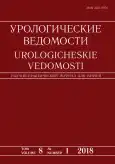Assesment of the efficiency of conservative treatment of Peyronie’s disease
- Authors: Kalinina S.N.1, Fesenko V.N.1, Nikolskii A.V.2, Burlaka O.O.2, Marchenko N.V.2
-
Affiliations:
- North-Western State Medical university named after I.I. Mechnikov
- Aleksandrovskaya Hospital
- Issue: Vol 8, No 1 (2018)
- Pages: 5-10
- Section: Articles
- URL: https://journals.rcsi.science/uroved/article/view/8692
- DOI: https://doi.org/10.17816/uroved815-10
- ID: 8692
Cite item
Abstract
There were 27 men under observation who got conservative treatment for Peyronie's disease. The criteria for inclusion in the study were the maximum size of the plaque of the penis up to 1.5 cm and the angle of curvature of the penis is less than 45 degrees. Before treatment, after 6 and 12 months, patients underwent ultrasonic dopplerography of the penis, the velocity of blood flow in the cavernous and dorsal arteries and the size of the plaque were determined. All observed patients were prescribed combined therapy, such as symptomatic, immunological and physiotherapeutic treatment. In this case, the patients of the 1st group (n = 15) additionally got longidase treatment (intramuscularly for 3000 IU every 3 days, for a course of 10 injections with concurrent administration of rectal suppositories with longidase at the same dose for a course of 10 suppositories). Locally, these patients were assigned phonophoresis with lengidase on the plaque area (10 sessions). The remaining 12 patients (2nd group) didn’t got longidase treament. Six months after the start of treatment the absence of plaques was recorded in 8 (53.3%) patients in the 1st group and 4 (33.3%) in the 2nd group of patients and in 12 months in 11 (73.3%) and 6 (41.6%) patients. Thus, conservative therapy in Peyronie's disease is effective in patients in the early stages of the disease with moderate deviation of the penis and plaques up to 1.5 cm. The inclusion of longidase in the complex therapy increases the effectiveness of the treatment.
Full Text
##article.viewOnOriginalSite##About the authors
Svetlana N. Kalinina
North-Western State Medical university named after I.I. Mechnikov
Author for correspondence.
Email: kalinina_sn@mail.ru
Doctor of Medical Science, Professor, Urology Department
Russian Federation, Saint PetersburgVladimir N. Fesenko
North-Western State Medical university named after I.I. Mechnikov
Email: fesvn_spb@mail.ru
Candidate of Medical Science, Associate Professor, Urology Department
Russian Federation, Saint PetersburgAnton V. Nikolskii
Aleksandrovskaya Hospital
Email: fesvn_spb@mail.ru
Candidate of Medical Science, Urologist, Department of Urology
Russian Federation, Saint PetersburgOleg O. Burlaka
Aleksandrovskaya Hospital
Email: burlaka@list.ru
Candidate of Medical Science, Head of Department of Urology
Russian Federation, Saint PetersburgNatalia V. Marchenko
Aleksandrovskaya Hospital
Email: burlaka@list.ru
Head of Department of Physiotherapy
Russian Federation, Saint PetersburgReferences
- Щеплев П.А., Гарин Н.Н., Данилов И.А., и др. Болезнь Пейрони. – М.: ИД «АБВ-пресс», 2012. [Shheplev PA, Garin NN, Danilov IA, et al. Bolezn’ Pejroni. Moscow: ABV-press; 2012. (In Russ.)]
- Урология. Российские клинические рекомендации / Под ред. Ю.Г. Аляева, П.В. Глыбочко, Д.Ю. Пушкаря. – М.: ГЭОТАР-Медиа, 2015. [Urologija. Rossijskie klinicheskie rekomendacii. Ed. by Yu.G. Aljaev, P.V. Glybochko, D.Yu. Pushkar. Moscow: GEOTAR-Media; 2015. (In Russ.)]
- Sommer F, Schwarzer U, Wassmer G, et al. Epidemiology of Peyronie’s disease. International Journal of Impotence Research. 2002;14(5):379-383. doi: 10.1038/sj.ijir.3900863.
- La Pera G, Pescatori ES, Calabrese M, et al. Peyronie’s disease: prevalence and association with cigarette smoking: a multicenter population-based study in men aged 50-69 years. European Urology. 2001;40(5):525-530. doi: 10.1159/000049830.
- Щеплев П.А., Данилов И.А., Колотинский А.Б., и др. Клинические рекомендации. Болезнь Пейрони // Андрология и генитальная хирургия. – 2007. – № 1. – С. 55–58. [Shheplev PA, Danilov IA, Kolotinskij AB, et al. Klinicheskie rekomendacii. Bolezn’ Pejroni. Andrologija i genital’naja hirurgija. 2007;(1):55-58 (In Russ.)]
- Калинина С.Н., Тиктинский О.Л., Новиков И.Ф. Фибропластическая индурация полового члена (болезнь Пейрони): Пособие для врачей-урологов. – СПб.: Изд-во СПбМАПО, 2009. [Kalinina SN, Tiktinskij OL, Novikov IF. Fibroplasticheskaja induracija polovogo chlena (bolezn’ Pejroni). Posobie dlja vrachej-urologov. Saint Petersburg: SPbMAPO; 2009. (In Russ.)]
- Тиктинский О.Л., Калинина С.Н., Михайличенко В.В. Андрология. – М.: МИА, 2010 [Tiktinskij OL, Kalinina SN, Mihajlichenko VV. Andrologija. Moscow: MIA; 2010. (In Russ.)]
- Мазо Е.Б., Муфагед М.Л., Иванченко Л.П., и др. Консервативное лечение болезни Пейрони в свете новых патогенетических данных // Урология. – 2006. – № 2. – С. 31–37 [Mazo EB, Mufaged ML, Ivanchenko LP, et al. Konservativnoe lechenie bolezni Pejroni v svete novyh patogeneticheskih dannyh. Urologiia. 2006;(2):31-37. (In Russ.)]
- Adeniyi AA, Goorney SR, Pryor JP, Ralph DJ. The Lue procedure: an analysis of the outcome of Peyronie’s disease. BJU Int. 2002;89(4):404-408. doi: 10.1046/j.1464-4096.2001.01896.x.
- Levine LA, Goldman KE, Greenfild JM. Experience with intraplaque injection of Verapamil for Peyronie’s disease. J Urol. 2002;168(2):621-625. doi: 10.1097/00005392-200208000-00045.
- Москалева Ю.С., Остапченко А.Ю., Корнеев И.А. Болезнь Пейрони // Урологические ведомости. – 2015. – Т. 5. – № 4. – С. 30–35 [Moskaleva YuS, Ostapchenko AYu, Korneev IA. Peyronie’s disease. Urologicheskie vedomosti. 2015;5(4):30-35. (In Russ.)]
- Сокольщик М.М., Гагарина С.В., Петрович Р.Ю., и др. Лечение эректильной дисфункции у пациентов с пластической индурацией полового члена // Урология. – 2008. – № 1. – С. 41–44. [Sokol’shhik MM, Gagarina SV, Petrovich RJu, et al. Lechenie jerektil’noj disfunkcii u pacientov s plasticheskoj induraciej polovogo chlena. Urologiia. 2008(1):41-44. (In Russ.)]
- Lebret T, Loison G, Herve JM, et al. Extracorporeal shock wave therapy in the treatment of Peyronie’s disease: experience with standard lithotripter (Siemens-Multiline). Urology. 2002;59(5):657-661. doi: 10.1016/s0090-4295(02)01527-3.
Supplementary files










